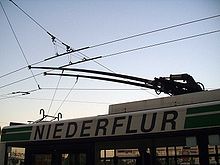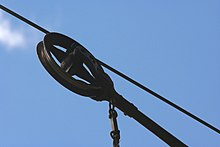
Back Щангов токоприемник Bulgarian Tyčový sběrač proudu Czech Τρόλεϊ πόλο Greek Troleo Esperanto Trole de pértiga Spanish Tankovirroitin Finnish Troleo IO Asta di captazione Italian 集電装置#トロリーポール Japanese 트롤리 폴 Korean


A trolley pole is a tapered cylindrical pole of wood or metal, used to transfer electricity from a "live" (electrified) overhead wire to the control and the electric traction motors of a tram or trolley bus. It is a type of current collector. The use of overhead wire in a system of current collection is reputed to be the 1880 invention of Frank J. Sprague,[1] but the first working trolley pole was developed and demonstrated by Charles Van Depoele, in autumn 1885.[2]

An early development of an experimental tramway in Toronto, Ontario, was built in 1883, having been developed by John Joseph Wright, brother of swindler Whitaker Wright. While Wright may have assisted in the installation of electric railways at the Canadian National Exhibition (CNE), and may even have used a pole system, there is no evidence about this. Likewise, Wright never filed or was issued a patent.[3]
Credit for development of the first working trolley pole is given to Charles Joseph Van Depoele, a Belgian engineer who moved to the United States in 1869. Van Depoele made the first public demonstration of the spring-loaded device on a temporary streetcar line installed at the Toronto Industrial Exhibition (now the CNE) in autumn 1885.[2] Depoele's first trolley pole was "crude" and not very reliable, and he reverted to using the troller system of current collection for a commercial installation on a streetcar system in South Bend, Indiana, which opened on November 14, 1885, and on one in Montgomery, Alabama, in April 1886. However, within a few months, Van Depoele switched to the trolley-pole system for the Montgomery operation.[2] Van Depoele and fellow inventor Frank J. Sprague were "working on similar ideas at about the same time",[4] and Sprague employed trolley-pole current collection on an electric streetcar system he installed in Richmond, Virginia, in 1888, also improving the trolley pole wheel and pole designs. Known as the Richmond Union Passenger Railway, this 12-mile (19 km) system was the first large-scale trolley line in the world, opening to great fanfare on February 12, 1888.[5]

The grooved trolley wheel was used on many large city systems through the 1940s and 1950s; it was generally used on systems with "old" style round cross sectional overhead wire. The trolley wheel was problematic at best; the circumferential contact of the grooved wheel bearing on the underside of the overhead wire provided minimal electrical contact and tended to arc excessively, increasing overhead wire wear. The newer sliding carbon trolley shoe was generally used with a newer grooved overhead trolley wire of a roughly "figure 8" cross section. The sliding trolley shoe provided better electrical contact (with a reduction in arcing), and it dramatically reduced overhead wire wear. Many systems began converting to the sliding trolley shoe in the 1920s; Milwaukee, Wisconsin converted its large system in the late 1920s. Philadelphia did not convert its trolley wheels on its remaining streetcars until 1978.[citation needed] Although a streetcar with a trolley wheel may evoke an antique look, the trolley shoe is modern and more practical as well as economical.
- ^ Koebel, Romin (2005). "Boston Transit Milestones". MIT Open Courseware. Archived from the original on 2006-09-20. Retrieved 2012-08-01.
- ^ a b c Middleton, William D. (1967). The Time of the Trolley, pp. 63–65, 67. Milwaukee: Kalmbach Publishing. ISBN 0-89024-013-2.
- ^ "Patents of Invention and the Story of Canadian Innovation". Library and Archives Canada.
- ^ Middleton (1967), p. 67.
- ^ "Electric Trolley System". Massachusetts Institute of Technology. Archived from the original on 2006-09-13.
© MMXXIII Rich X Search. We shall prevail. All rights reserved. Rich X Search